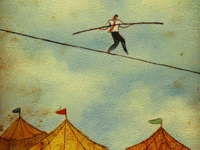Strategic Modeling: Balancing Structure with Choice
Your content has been saved!
Go to My Saved Content.Early in my teaching career, I viewed students' struggles as a temporary phase that would end once they started working harder and "figured it out." Students would come to me with questions, or I would notice their confusion and talk with them, but I was very careful not to give them too much information. I was a progressive educator, and if I shared too many ideas, the work would be mine, and not theirs (or so I told myself).
For my classroom, I still strongly believe in the concept of student as worker, teacher as coach (thank you CES), and I continue to structure learning so that students -- and not the teacher -- are the focus. And yet, the more I've become aware of my own learning process, the more I've come to value the importance of strategic modeling for students.
When I feel stuck in the midst of a project of my own, or when I am attempting something that is beyond my knowledge base, I turn to others as I slowly figure out my own path. There is no way that my writing, my teaching, my parenting or even my plumbing could have improved were it not for conversations I had with others, and for outside examples that moved my thinking forward.
Figuring Out the Balance
While modeling is very important for student success, we can easily forget that it needs to be done with tact and strategy. It's tempting to make content clear enough so that students can immediately "get it." The problem is that this practice removes certain meaningful and engaging experiences of discovery and creativity.
My goals are to create situations where all students feel that they have a clear understanding of a framework that can guide them in their work. This means there is some modeling that I will do for a whole class and some modeling that I will share only with students who are struggling. The continual dance is to find examples to share that provide enough information for students to move forward while maintaining their own, individualized processes of creation.
Examples of Modeling
Sharing a Sample Project
In my English classes, I have assigned a project in which students have to interview someone from their community and create an audio podcast related to the theme of "crossing boundaries." Because the project involves skills that are new to many students and a product that is not necessarily familiar, I use excerpts from the radio show This American Life as a model. As a class, we analyze the form, discover different ways that storytellers allow stories to unfold, and speak in depth about editing. These models offer students a vision of how their own work can proceed. Here is an example of a powerful podcast made by Briana (interview content starts at 00:35).
Modeling Thinking
I work with my students to create complex thesis statements that are controversial, specific and debatable. Because this is new to many of them, we first go over the criteria together, and then I have groups create both good and bad thesis statements about their favorite TV shows. As groups share their examples aloud, I will model the thinking for them by sharing ideas to help them revise on the spot and make their thesis statements stronger.
Having Peers Share Their Work
I try to seize every opportunity to highlight quality student work as a model for others. In a unit on poetry, we all worked together on a wiki where each student had his or her own page. As students were creating their poetry portfolios, I would begin classes by projecting different students' pages and pointing out interesting techniques and exceptional work as models for others to emulate.
Helping a Struggling Student
Last year, one of my students hit a wall every time he began a writing assignment. He would sit, staring at his blank computer screen, getting more and more disconsolate as the people around him progressed with their work. The more I worked with this student, the more it became apparent that once he had a beginning, he could proceed with the rest of the work on his own. I began to check in with him in the early stages of projects and ask him his ideas. Once I had heard some of his early thoughts, I would offer him some sample opening sentences that I created on the spot. This small amount of modeling often made it possible for him to find a way to proceed with his work.
The Attentive Educator
Learning is a messy, communal, back-and-forth process. Just as we look to peers and outside inspiration to enrich our own teaching and learning, we should remember that students need a balance between structure and choice. Too much structure can remove individual investment and creativity. When choice is not backed up with clear modeling of expectations and guidelines, many are left unsure of how to proceed. As educators, if we are more attentive to the dance of structure and choice, we enable more students to produce work that is both powerful and profound.
